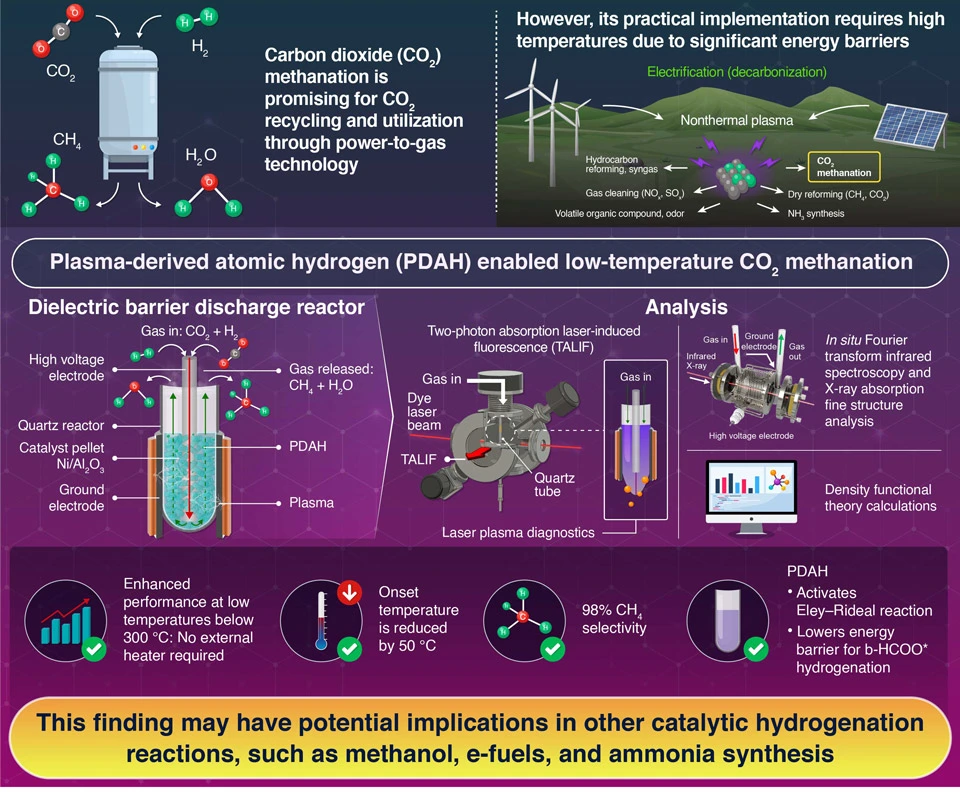Plasma-Derived Atomic Hydrogen Advances Low-Temperature CO2 Methanation at High Yield
Scientists developed a new method that enables low-temperature carbon dioxide methanation using plasma-derived atomic hydrogen
Plasma-derived atomic hydrogen (PDAH) enables low-temperature carbon dioxide methanation reaction through the Eley−Rideal-type reaction channel, improving methane yield at low temperatures, as shown by scientists at Science Tokyo. The findings underscore the potential of PDAH in advancing sustainable carbon dioxide recycling methods and optimizing other catalytic hydrogenation reactions, providing a promising avenue for improved efficiency in various energy and environmental technologies.
New Energy-Efficient Carbon Dioxide Recycling Method Using Plasma-Derived Atomic Hydrogen

Kim et al. (2024) | JACS Au
Despite declining reserves and significant carbon dioxide (CO2) emissions contributing to climate change, fossil fuels continue to be the most widely used energy source globally. This pressing environmental issue has led researchers to seek methods for reducing atmospheric CO2. One promising approach is CO2 methanation, a process that converts CO2 into methane–a cleaner fuel, by reacting it with green hydrogen in the presence of a metal catalyst.
CO2 methanation is thermodynamically more efficient at low temperatures, ideally allowing the heat of the reaction to sustain it. However, in practice, this reaction must be conducted at high temperatures, requiring an external heat source. This is because the atomic hydrogen, formed by the adsorption and dissociation of hydrogen molecules on the catalyst surface, becomes immobilized and stabilized on the catalyst, reducing its reactivity and necessitating high temperatures to overcome the energy barrier for the rate-determining step. This creates challenges like high energy consumption, carbon deposition on the catalyst, and the formation of unwanted by-products such as carbon monoxide (CO). Fully harnessing the chemical reactivity of atomic hydrogen is crucial for improving CO2 methanation.
To address these issues, a research team from Japan, led by Professor Tomohiro Nozaki, from the Department of Mechanical Engineering at the Institute of Science Tokyo, investigated an innovative plasma-assisted system that enables low-temperature CO2 methanation using PDAH. Their findings were published in the journal JACS Au.
Plasma catalysis, which combines nonthermal plasma (NTP) with conventional metal-supported catalysts, has recently gained considerable attention due to the synergistic interactions it creates between the plasma and the catalyst. NTP consists of electrons at a much higher temperature than the bulk gas. “Studies have demonstrated low-temperature CO2 methanation using plasma catalysis, but an understanding of the reaction dynamics and mechanisms is still lacking. Moreover, the nature and reactivity of PDAH has rarely been explored,” explains Nozaki.
To understand the underlying dynamics of plasma-assisted CO2 methanation, the team conducted a detailed study using kinetic analysis, laser plasma diagnostics, in situ plasma surface characterization, and quantum chemistry calculations. They performed CO2 methanation with Ni/Al2O3, as a non-precious metal catalyst, in a packed-bed dielectric barrier discharge (DBD) reactor. In this setup, a mixture of CO2 and hydrogen gas is partially ionized, producing NTP and thus highly reactive PDAH.
The researchers found that the activity of CO2 methanation under DBD conditions demonstrated high activity even at low temperatures below 300 ℃. Remarkably, at around 230 ℃, the CO2 conversion rates under DBD conditions were 11 times higher than those achieved with thermal catalysis, while maintaining methane selectivity above 98%. Moreover, since DBD does not heat the product gas, it prevents the formation of unwanted by-products. Quantum chemistry calculations further revealed that PDAH lowers the energy barrier of the reaction intermediates by activating the Eley−Rideal-type reaction pathway, facilitating the low-temperature CO2 methanation.
“Our study highlights the important role of PDAH in catalytic CO2 methanation. Our findings can also be applied to other catalytic hydrogenation processes, including methanol, hydrocarbon, and ammonia production,” remarks Nozaki, highlighting potential applications.
Moreover, the Power-to-X concept would gain momentum with the plasma technologies driven by renewable energy, which also contributes to a low-carbon society.
Overall, this study provides new insights into plasma-assisted CO2 methanation, paving the way for more energy-efficient and sustainable CO2 recycling.
Reference
- Authors:
- Dae-Yeong Kim1, Yoshinobu Inagaki2, Tsukasa Yamakawa2, Bang Lu3, Yoshiaki Sato3, Naoki Shirai2, Shinya Furukawa4, Hyun-Ha Kim5, Satoru Takakusagi3, Koichi Sasaki2, and Tomohiro Nozaki1
- Title:
- Plasma-Derived Atomic Hydrogen Enables Eley–Rideal-Type CO2 Methanation at Low Temperatures
- Journal:
- JACS Au
- Affiliations:
- 1 Department of Mechanical Engineering, Tokyo Institute of Technology, Japan
2 Division of Applied Quantum Science and Engineering, Hokkaido University, Japan
3 Institute for Catalysis, Hokkaido University, Japan
4 Division of Applied Chemistry, Osaka University, Japan
5 National Institute of Advanced Industrial Science and Technology, Japan
Related articles
Further information
School of Engineering, Institute of Science Tokyo
Assistant Professor Dae-Yeong Kim
- Tel
- +81-3-5734-3847
- kim.d.as@m.titech.ac.jp
Contact
Public Relations Division, Institute of Science Tokyo
- Tel
- +81-3-5734-2975
- media@ml.tmd.ac.jp